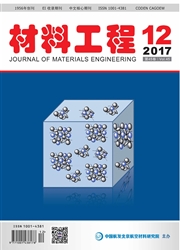

 中文摘要:
中文摘要:
利用包埋共渗法在Ti—Nb—Si基超高温合金表面制备了Si-Cr共渗涂层,共渗温度为1350℃,时间为10h。将Si—Cr共渗后的试样在1250℃下分别氧化5,10,20,50h和100h。利用SEM,EDS和XRD等分析方法研究了涂层及氧化后氧化膜的结构、元素分布及相组成。结果表明,氧化前Si—cr共渗涂层分为4层:最外层为(Ti,X)5Si3(X代表Nb,Hf和Cr元素)和(Nb1.95Cr1.05)Cr2Si。3次外层为(Ti,X)5Si3,中间层为(Ti,X)5Si4,过渡层为(Ti,X)5Si3。涂层试样在1250℃氧化后形成的氧化膜分为两层:外层为(Ti,Nb,Cr)O2,下层为SiO2。未加涂层的试样在1250℃氧化遵循直线规律。加涂层的试样在1250℃氧化遵循分段抛物线规律,5~20h内为Y=15.81+3.92t1/2,20~100h内为Y=-82.71+27.12t1/2。在20~100h内氧化的抛物线速率常数比5~20h内氧化的大约高1个数量级。具有高Cr含量的外层比中间层及过渡层具有较好的抗氧化性。
 英文摘要:
英文摘要:
Si-Cr co-deposition coatings were prepared on a Ti-Nb-Si based ultrahigh temperature alloy by pack cementation processes at 1350℃ for 10h. The oxidation behaviors of the coating specimens were examined isothermally at 1250℃ for 5, 10, 20, 50h and 100h in static air. X-ray diffraction analysis (XRD) and scanning electron microscopy with energy dispersive spectroscopy (SEM/EDS) were used to identify the microstructure, compositional distribution and phase constituents of both coating and the scale developed during oxidation. The results revealed that the Si-Cr co-deposition coating was composed of 4 layers. The outermost layer was mainly composed of (Nb1.95Cr1.05)Cr2Si3 and (Ti, X)5Si3 phases (X represents Nb, Cr and Hf elements). Both the sublayer and transitional layer consisted of (Ti,X)5Si3, and (Ti,X)5Si4 was found as the main phase constituent in the intermediate layer. The oxidation of the coating specimens at 1250℃ resulted in the formation of scales with an outer layer composed of Nb, Cr doped TiO2 and an under layer composed of SiO2. The oxidation kinetics of the bare alloy at 1250℃ followed a linear law. However, the oxidation kinetics of the coating specimens could be described in terms of piecewise parabolic laws. The parabolic equation was y=15.81+ 3.92t1/2 within 20h, and it was y=-82.71+27.12t1/2 from 20h to 100h. The parabolic rate constant within 20h was lower than that from 20h to 100h by 1 order of magnitude. The outer layer with a higher Cr content had a better oxidation resistance than both intermediate layer and transitional layer of the coating at 1250℃.
 同期刊论文项目
同期刊论文项目
 同项目期刊论文
同项目期刊论文
 Structure of Al-modified silicide coatings on an Nb-based ultrahigh temperature alloy prepared by pa
Structure of Al-modified silicide coatings on an Nb-based ultrahigh temperature alloy prepared by pa Structure and oxidation behavior of Si-Y co-deposition coatings on an Nb silicide based ultrahigh te
Structure and oxidation behavior of Si-Y co-deposition coatings on an Nb silicide based ultrahigh te 期刊信息
期刊信息
